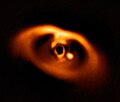Planetary system

The innermost planet, b, is a super-Earth and the outermost planet, c, is a mini-Neptune. They were discovered together in 2019. [3] The middle planet, d, is an Earth-mass world discovered in 2023. It may potentially be tidally heated by interactions with planet c, which would lead to abundant volcanoes similar to Jupiter's moon Io. [5] As the planet d is in the inner edge of the habitable zone, liquid water could condense on the side of the planet that faces away from the host star. [6]
In 2021 planet c was suggested for atmospheric analysis by the James Webb Space Telescope (JWST). [7] In 2025, by using JWST the atmosphere of planet c was found to be rich in haze and methane (CH4) but without clear evidence for carbon dioxide (CO2), which is unlike that of other temperate sub-Neptune planets including K2-18b and TOI-270d. [8]
| Companion (in order from star) | Mass | Semimajor axis (AU) | Orbital period (days) | Eccentricity | Inclination | Radius |
|---|---|---|---|---|---|---|
| b | — | 0.00978±0.00012 | 0.9479981±0.0000021 | — | 88.37+0.94 −0.95 ° | 1.212+0.059 −0.058 R🜨 |
| d | 0.91±0.19 M🜨 | 0.01992±0.00014 | 2.753436±0.000013 | 0.0011+0.0010 −0.0008 | 89.34±0.41° | 1.032+0.044 −0.043 R🜨 |
| c | 7.16±0.65 M🜨 | 0.02961+0.00035 −0.00036 | 4.9899100+0.0000012 −0.0000014 | 0.0001±0.0001 | 89.94±0.05° | 2.488±0.096 R🜨 |
